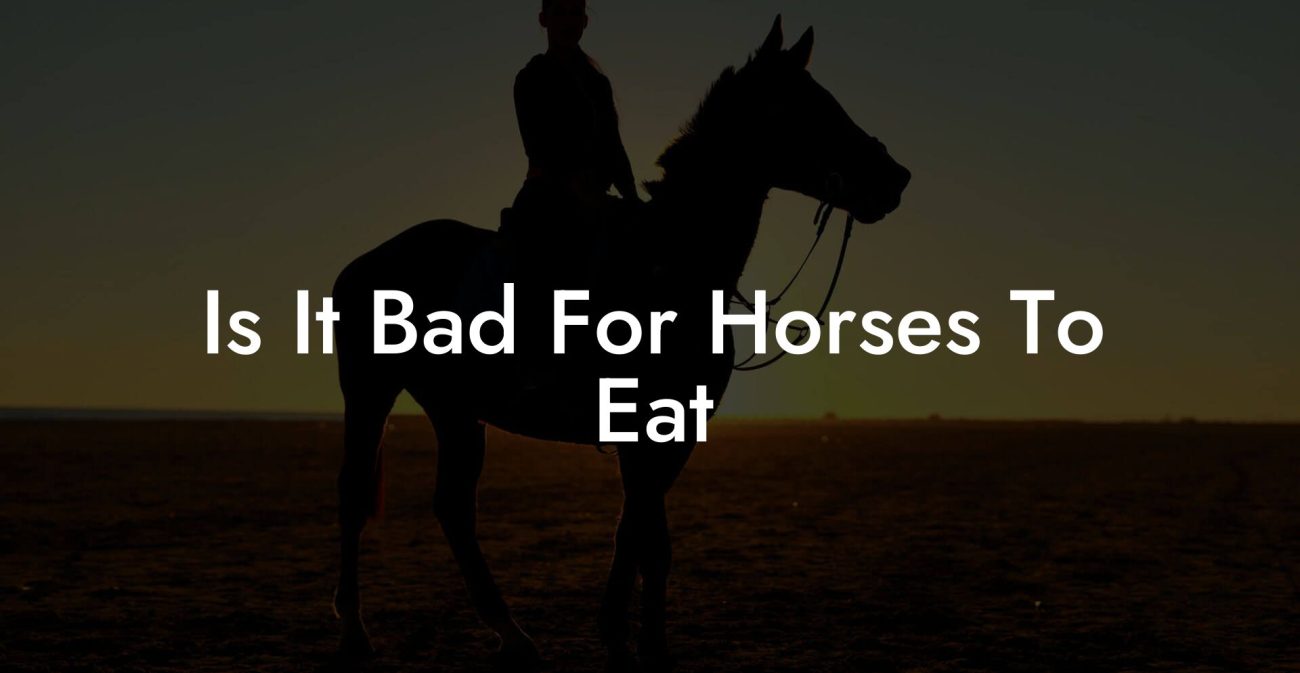Ever wondered if your four-legged friend would trade an extra carrot for a big helping of Bermuda? If you’re like many savvy Gen-Z and millennial equine enthusiasts, you’re constantly looking for innovative yet practical ways to nourish your horse. In this deep-dive guide, we’re tackling one of the most common questions in horse care today: “How Much Bermuda Should A Horse Be Fed Per Day?” Get ready for a wild ride through the world of equine nutrition, as we blend science, humor, and down-to-earth advice into a feast of information that will leave both you and your horse happier than ever.
Quick Links to Useful Sections
- The Lowdown on Bermuda: More Than Just a Beach Paradise
- What Makes Bermuda Grass a Superstar in Equine Nutrition?
- Understanding Horse Nutrition: How Much Feed Does Your Equine Need?
- Key Factors Affecting Bermuda Feeding Requirements
- 1. Body Weight and Size
- 2. Age and Life Stage
- 3. Activity Level
- 4. Quality of the Bermuda Hay
- 5. Health and Metabolic Status
- Calculating the Ideal Bermuda Hay Intake: Step-by-Step
- Step 1: Weigh Your Horse
- Step 2: Decide on the Percentage
- Step 3: Factor in Additional Considerations
- Step 4: Monitor and Adjust
- Mixing It Up: Bermuda Hay and a Balanced Equine Diet
- Incorporating Pasture Access
- Grains and Concentrates
- Vitamins and Minerals
- Troubleshooting Your Bermuda Feeding Routine
- Overfeeding vs. Underfeeding
- Changing Hay Quality and Seasonal Variations
- Behavioral Issues and Feed Aversions
- Monitoring Digestive Health
- Best Practices for Feeding Bermuda Hay
- Innovative Feeding Tools and Tech for the Modern Horse Owner
- Smart Scales and Weigh Tapes
- Automated Feeder Systems
- Mobile Apps and Digital Journals
- Resources and Community Support: Your Next Steps
- Staying Ahead: Monitoring, Adapting, and Evolving Your Horse’s Diet
- Real-Life Stories: How Modern Horse Owners Are Embracing Bermuda Feeding
- The Energetic Trailblazer
- The Retired Show Jumper’s New Chapter
- From Skeptic to Believer
- Your Equine Nutrition Blueprint: Personalized Feeding Strategies
- Step 1: Gather the Essentials
- Step 2: Set Clear Nutrition Goals
- Step 3: Create a Balanced Feed Mixture
- Step 4: Monitor Progress and Fine-Tune
- Step 5: Consult and Collaborate
- Equine Feeding FAQs: Your Burning Questions Answered
- Your Journey to Equine Nutritional Mastery Starts Now
The Lowdown on Bermuda: More Than Just a Beach Paradise
When you hear the word “Bermuda,” you might imagine turquoise waters, pink sand, and endless reggae beats. However, in the realm of horse care, Bermuda means something totally different, Bermuda grass. Known for its coarse texture and hearty nutritional profile, Bermuda grass is a popular hay choice for horses, especially when growing conditions favor its lush, green quality. It’s time to separate the tropical vacation vibes from the barnyard reality and get down to the nitty-gritty of how much of this star athlete in the hay world your horse truly needs.
In this guide, we’re not only answering the big question about Bermuda feeding amounts but also exploring why this grass is making such a buzz among equine nutrition enthusiasts. Think of Bermuda hay as a power-packed meal, it’s loaded with energy, fiber, and essential nutrients that echo the benefits of a balanced diet in your own kitchen. So, saddle up and join us as we break down everything you need to know, from the nutritional benefits of Bermuda grass to the factors that could affect your horse's daily dietary requirements.
What Makes Bermuda Grass a Superstar in Equine Nutrition?
Bermuda grass isn’t just any hay, it’s a nutritional dynamo that brings several benefits to your equine companion’s diet. Here’s why this seemingly humble grass is making headlines among equine enthusiasts:
- High Digestibility: Bermuda hay is well-known for its excellent digestibility. Its fiber is moderate, meaning it provides enough bulk to aid digestion without overwhelming the horse’s system.
- Energy Boost: With adequate carbohydrate levels, Bermuda hay gives horses the energy they need for work, play, and everything in between. This is especially important for performance horses or those with high activity levels.
- Nutrient Rich: Loaded with essential vitamins and minerals, Bermuda grass supports overall health, from robust muscle function to a shiny coat that sparkles in the sunlight (or barn light).
- Versatile and Palatable: Horses are known for their selective eating habits, but many appreciate the palatable taste of Bermuda hay. It can be fed alone or mixed with other hays to create a balanced diet.
By now, you might be thinking, “That sounds amazing, but how do I figure out the right amount?” Fear not, because we’re about to break down the key considerations that will help you tailor your horse’s Bermuda hay intake to perfection.
Understanding Horse Nutrition: How Much Feed Does Your Equine Need?
Horses are not one-size-fits-all when it comes to nutrition. Just like us humans, our equine friends have unique dietary needs based on several factors. Before you start measuring out bales of Bermuda hay like a seasoned equine chef, it’s essential to understand the basics of horse nutrition.
In general, the amount of forage, like Bermuda hay, that a horse requires is usually measured as a percentage of its body weight. Most experts recommend that horses receive between 1.5% and 2.5% of their body weight in forage each day. However, factors such as age, weight, metabolism, and activity level can all impact this percentage.
For example, a young, active performance horse will typically need more energy to fuel those barnyard boot camps than a mellow senior horse grazing in the pasture. In addition, factors like climate and the quality of the hay also play a role. Warmer weather or more vigorous exercise can boost a horse’s nutritional demands, meaning you might need to slightly adjust those feeding levels.
Key Factors Affecting Bermuda Feeding Requirements
When it comes to determining just how much Bermuda hay to feed your horse daily, keeping an eye on these factors will help you craft a diet that’s both nutritious and satisfying:
1. Body Weight and Size
At the core of determining feeding amounts is your horse’s body weight. A standard rule of thumb is to feed about 1.5% to 2.5% of your horse’s body weight in forage. For instance, if your horse weighs 1,000 pounds, that translates to roughly 15 to 25 pounds of hay per day. However, it’s crucial to adjust this range based on your horse’s metabolism and lifestyle.
2. Age and Life Stage
Younger horses, such as growing foals or weanlings, and older horses might have different requirements compared to middle-aged, high-performance adults. Growing horses need additional nutrients to support bone and muscle development. Conversely, older horses might require more digestible forage to accommodate potential dental issues or slower metabolism.
3. Activity Level
Is your horse a track star or a laid-back grazing enthusiast? Active horses burning calories at a high rate require more energy, so they generally need an increased intake of Bermuda hay. On the other hand, horses that lead a calm life in a pasture might require a more modest amount.
4. Quality of the Bermuda Hay
Not all hay is created equal. Bermuda hay’s moisture content, fiber quality, and nutrient density must be factored into the feeding equation. High-quality Bermuda hay with a balanced nutrient profile might allow you to stick closer to the lower end of the feeding spectrum, whereas lower-quality hay might necessitate an increased amount to meet nutritional needs.
5. Health and Metabolic Status
Horses with metabolic issues or chronic conditions may have specialized dietary needs. In these cases, it’s always wise to consult with an equine nutritionist or veterinarian. They can help tweak your horse’s diet, ensuring that feeding amounts not only meet energy requirements but also support overall health and longevity.
Calculating the Ideal Bermuda Hay Intake: Step-by-Step
Now that we’ve covered the factors that affect feeding, let’s break it down into a simple formula to help you determine exactly how much Bermuda hay your horse should get each day.
Step 1: Weigh Your Horse
The first step is to ascertain your horse’s body weight. Using a weight tape or a scale (if available) can give you a pretty solid number. If your horse is a bit on the chubby side, knowing the weight helps in adjusting the feed to avoid overfeeding.
Step 2: Decide on the Percentage
As mentioned, the typical range is between 1.5% and 2.5% of body weight. For a healthy, moderately active horse, 2% is often a safe starting point. For example, if your horse weighs 1,000 pounds, 2% would mean 20 pounds of Bermuda hay each day.
Step 3: Factor in Additional Considerations
Adjust the base amount depending on factors like activity level, climate, and overall health. For a high-performance athlete hogging the show in the dressage arena, you might push closer to 2.5% or even a bit beyond. Conversely, a retired horse may do well at around 1.5% to 2%.
Step 4: Monitor and Adjust
Once you’ve established a baseline, keep a close eye on your horse’s weight, body condition, and behavior. Any noticeable change could signal that it’s time to adjust the feeding amounts. Remember, feeding isn’t static, it’s a dynamic process that should be tuned over time.
Equipped with this straightforward calculation method, you’re ready to make decisions that keep your equine buddy energized and in fine form, all while ensuring that the diet is sustainable and cost-effective.
Mixing It Up: Bermuda Hay and a Balanced Equine Diet
While Bermuda hay is a fantastic foundation for many horse diets, it rarely works in isolation. Just like a smoothie in the morning benefits from a mix of fruits, greens, and a dash of protein powder, your horse’s diet should blend Bermuda with other essential components.
Here are some ways to ensure the diet remains balanced:
Incorporating Pasture Access
When weather and pasture conditions allow, supplementing Bermuda hay with grazing can enhance dental health, natural behaviors, and overall satisfaction. Free access to fresh pasture encourages movement, mental stimulation, and can help maintain optimum gut function.
Grains and Concentrates
For horses who have specific performance goals or higher energy needs, a measured amount of grains can supplement the Bermuda hay. However, it’s important to note that too many concentrates can lead to digestive issues, so think of them as that little extra spice rather than the main course.
Vitamins and Minerals
In some cases, additional supplementation might be required to fill any nutritional gaps. Consult your veterinarian or equine nutritionist to see if your horse would benefit from added vitamins, minerals, or even special feeds to prevent deficiencies.
Balancing Bermuda hay with other dietary components creates harmony in your horse’s digestive tract and ensures that every meal contributes to overall health. Think of it as crafting a Michelin-star meal for your equine companion, with Bermuda hay serving as a star ingredient.
Troubleshooting Your Bermuda Feeding Routine
Even the best-laid feeding plans occasionally encounter bumps in the pasture. Here are some common challenges you might face when feeding Bermuda hay and tips to keep your equine friend thriving:
Overfeeding vs. Underfeeding
It can be surprisingly easy to swing too far in either direction. Overfeeding can lead to weight gain, colic, or digestive disturbances, while underfeeding might result in nutrient deficiencies and a drop in performance. Keep a regular eye on your horse’s body condition score, and adjust the feed amounts gradually rather than making sudden, drastic changes.
Changing Hay Quality and Seasonal Variations
The nutritional profile of Bermuda hay can vary by season. During peak growth periods, the hay might be lush and nutrient-dense, whereas in cooler months, the fiber content can change. Be sure to recalibrate your feeding strategy as the hay’s quality shifts throughout the year.
Behavioral Issues and Feed Aversions
Horses can be finicky eaters. Some might develop a taste for Bermuda hay while others may balk if there’s an abrupt change in texture or taste. Experiment with mixing a small amount of an alternative hay or offering Bermuda hay in different forms (e.g., chopped or shredded) until you find a routine that keeps your horse’s appetite satisfied.
Monitoring Digestive Health
Your horse’s manure is one of your best allies in determining if their diet is on track. Regular, healthy manure is a sign of good digestion. If you notice significant changes in consistency, frequency, or even color, it might be time to consult a veterinarian or adjust the forage-to-concentrate ratio.
Best Practices for Feeding Bermuda Hay
To ensure that your horse receives the optimal benefits from Bermuda hay, here are some best practices that integrate modern equine nutrition science with good old-fashioned barn wisdom:
- Consistent Feeding Schedule: Horses thrive on routine. Stick to a regular feeding schedule to promote stable digestive rhythms.
- Proper Storage and Handling: Keep your Bermuda hay dry, free from mold, and stored in a well-ventilated space. Good storage practices ensure that the nutritional quality is maintained.
- Monitor Water Intake: Adequate hydration is key to proper digestion. Always ensure that your horse has unlimited access to fresh, clean water.
- Gradual Dietary Changes: When transitioning to Bermuda hay or mixing it with other forages, do so gradually. This helps to avoid upsetting your horse’s gut flora.
- Regular Health Checkups: Schedule routine visits with your equine vet. Regular checkups can help catch nutritional imbalances or health issues before they become serious.
Following these best practices will not only improve your horse’s nutritional health but will also ease your mind knowing that you’re providing a diet that’s balanced, appropriate, and in tune with the latest in equine care research.
Innovative Feeding Tools and Tech for the Modern Horse Owner
The world of equine care has embraced technology, and modern horse owners are now equipped with a variety of tools to fine-tune their feeding routines. From smart scales to automated feed dispensers, these gadgets make it easier than ever to ensure that your horse is getting the perfect portion of Bermuda hay every single day.
Smart Scales and Weigh Tapes
While we mentioned using weight tapes, advancements in technology mean that you can now invest in smart scales designed specifically for large animals. These devices provide accurate readings and sync directly with your smartphone or tablet, ensuring you have up-to-date data on your horse’s body weight. This not only helps in calculating feed amounts but also assists in early detection of weight fluctuations.
Automated Feeder Systems
For tech-savvy equine owners, automated feeder systems take the guesswork out of portion control. These systems can be programmed to dispense pre-measured amounts of Bermuda hay at scheduled times throughout the day, ensuring consistency and preventing accidental overfeeding.
Mobile Apps and Digital Journals
Tracking your horse’s health has never been easier with mobile apps that allow you to log feed amounts, monitor water intake, record behavioral changes, and even set reminders for vet checkups. A digital journal can be your best friend when it comes to monitoring how well your current feeding routine is working.
Embracing these cutting-edge tools can not only streamline your routine but can also lead to better overall health for your horse by ensuring that dietary needs are met meticulously every day.
Resources and Community Support: Your Next Steps
Diving into the world of equine nutrition doesn’t have to be a solo venture. A vibrant community of horse enthusiasts, nutrition experts, and veterinary professionals is ready to help you refine your feeding regimen. Here are some resources and community connections to consider:
- Equine Nutrition Blogs and Forums: Join online communities where fellow horse owners share tips, success stories, and troubleshooting advice specifically about Bermuda hay feeding and other equine nutrition topics.
- Local Equine Events and Workshops: Attend workshops hosted by local veterinarians or feed companies. These events are a goldmine of information, offering both scientific insights and practical demonstrations on proper feeding techniques.
- Veterinary Consultations: Regularly consult with equine nutritionists and veterinarians who can provide personalized advice based on your horse’s health and activity level.
- Social Media Groups: Platforms like Instagram, Facebook, and TikTok are full of vibrant communities where horse lovers share daily routines, feeding hacks, and creative recipes that incorporate Bermuda hay.
- Educational Websites: Websites dedicated to equine health, such as those by trusted veterinary associations, often feature articles that break down the science behind feeding recommendations in an accessible language.
Taking advantage of these resources can empower you with the knowledge and community support to continually refine your approach. Whether you’re a newbie or a seasoned horse owner, there’s always something new to learn, and share, with your community.
Staying Ahead: Monitoring, Adapting, and Evolving Your Horse’s Diet
The journey of maintaining optimal equine nutrition is a dynamic process. Just as trends change in fashion, the nutritional needs of your horse can evolve based on work patterns, seasonal shifts, or changes in health status. Staying ahead means regularly assessing your horse’s performance, body condition, and overall well-being.
A proactive approach includes routine weight monitoring (with those smart scales we mentioned earlier), keeping a detailed feeding log, and being open to adjustments. Sometimes a slight tweak in the Bermuda hay percentage or the addition of a few nutrient-dense supplements can make all the difference in your horse’s energy levels and digestive health.
Remember, the key to success is flexibility and a commitment to learning. Engage with veterinarians, nutritionists, and your fellow equine aficionados to keep your feeding practices as up-to-date as the latest viral meme. The equestrian world is rapidly evolving, and so should your approach to a balanced diet rooted in quality Bermuda hay.
Real-Life Stories: How Modern Horse Owners Are Embracing Bermuda Feeding
To truly understand the transformative power of feeding Bermuda hay correctly, let’s explore a few real-life stories from horse owners who have seen remarkable results:
The Energetic Trailblazer
Jessica, a young urban equestrian, found that her once finicky horse was showing signs of sluggishness and digestive issues. After switching to a structured feeding plan centered around Bermuda hay, coupled with routine pasture access and a sprinkle of oats in the morning, her horse transformed into the life of the trail ride. Jessica’s story is a shining example of how modern feeding methods tailored to the unique energy requirements of high-spirited horses can lead to improved performance and overall happiness.
The Retired Show Jumper’s New Chapter
Mark’s seasoned mare had spent years competing in the ring and, like many retired athletes, was facing challenges with slower metabolism and reduced digestive efficiency. With guidance from an equine nutritionist, Mark adopted a feeding plan that featured a carefully measured daily allotment of Bermuda hay along with vital supplements to meet her changing needs. Over time, Mark noticed his mare regaining her vigor and enjoying a more balanced, stress-free life in the pasture.
From Skeptic to Believer
Then there’s Sarah, who was initially skeptical about making any changes to her horse’s long-standing diet. However, after reading up on the benefits of Bermuda hay and attending a local workshop, she decided to try a targeted feeding approach. Not only did her horse’s coat become noticeably shinier, but its energy levels skyrocketed, prompting Sarah to become a vocal advocate on social media for innovative equine nutrition practices.
These testimonials underscore the beauty of adapting classical feeding wisdom with a modern, integrative approach that appeals to both long-time and first-time horse owners alike.
Your Equine Nutrition Blueprint: Personalized Feeding Strategies
Crafting a personalized nutrition plan for your horse is akin to designing a bespoke outfit, every measurement, detail, and adjustment matters. Here’s a straightforward blueprint to help you develop a plan that caters to your horse’s individual needs:
Step 1: Gather the Essentials
Start by gathering all the necessary data: your horse’s current weight, body condition score, activity level, and any special dietary requirements suggested by your vet.
Step 2: Set Clear Nutrition Goals
Whether your objective is to boost energy for high-performance events, maintain a healthy weight in leisurely pasture days, or support recovery from a minor health hiccup, setting specific goals guides your feeding strategy.
Step 3: Create a Balanced Feed Mixture
Combine your chosen portion of Bermuda hay (calculated by body weight and tailored to activity level) with other complementary feed components. This might include small amounts of concentrates, access to fresh pasture, and mineral supplements as needed.
Step 4: Monitor Progress and Fine-Tune
Keep regular records of weight fluctuations, behavioral shifts, and any digestive changes. This ongoing data collection ensures that your plan remains responsive to your horse’s evolving needs.
Step 5: Consult and Collaborate
Engaging with professionals, such as your veterinarian and an equine nutritionist, can provide expert insights that further refine your strategy. Regular consultations are key to staying ahead of potential issues and ensuring long-term success.
Embrace this blueprint as a living document, one that evolves in harmony with your horse’s life, activity levels, and overall well-being. The goal is to build a sustainable, health-optimizing diet so your horse can thrive on every front.
Equine Feeding FAQs: Your Burning Questions Answered
To round-out our comprehensive guide, we’ve compiled answers to some of the most frequently asked questions about feeding Bermuda hay to horses. These insights are designed to help you fine-tune your equine nutrition game!
1. How much Bermuda hay should I feed a 1,000-pound horse per day?
Generally, a 1,000-pound horse should receive anywhere from 15 to 25 pounds of hay per day (1.5% to 2.5% of body weight), adjusted for its activity level and metabolic needs.
2. Can Bermuda hay be fed as the sole source of forage?
Yes, high-quality Bermuda hay can typically be the primary forage in your horse’s diet, especially when its nutrient profile meets the horse’s daily requirements. However, supplementing with pasture access or other hay types can enhance dietary variety.
3. What factors should I consider when adjusting Bermuda hay amounts?
Key factors include your horse’s body weight, age, activity level, health status, and the quality of the hay. Seasonal variations in the hay’s nutrient density may also require adjustments.
4. How can I tell if my horse is getting too much or too little Bermuda hay?
Regularly monitor your horse’s body condition, weight changes, and digestive health. Signs of overfeeding include weight gain and lethargy, while underfeeding may result in weight loss and poor coat condition.
5. Can I combine Bermuda hay with other feed types?
Absolutely. Integrating Bermuda hay with pasture and selective concentrates creates a balanced equine diet that meets all nutritional needs while adding variety.
6. Are there any special considerations for feeding Bermuda hay in different seasons?
Yes. The nutrient content of Bermuda hay can fluctuate with the seasons, so it’s important to periodically test the hay and adjust the quantity to ensure that your horse receives consistent nutrition year-round.
7. How often should I consult with a veterinarian or nutritionist about my horse's diet?
Regular consultations, at least annually or whenever notable changes in your horse’s performance or condition occur, are recommended to ensure that your feeding regimen remains optimal.
By staying informed and actively engaging with equine nutrition professionals, you can refine your feeding strategy over time and keep your horse at its best.
Your Journey to Equine Nutritional Mastery Starts Now
Feeding your horse isn’t merely about tossing out hay, it’s about creating a nourishing, balanced, and dynamic lifestyle for your equine friend. By embracing the insights shared in this guide, you’re not just following a trend but stepping into a realm where traditional care meets modern innovation.
Every bale of Bermuda hay represents a building block in your horse’s daily fuel, the foundation for energy, health, and overall vitality. Whether you’re a new horse owner still learning the ropes or a seasoned caretaker looking to optimize your feeding regimen, integrating precision, passion, and a pinch of creativity will set you on the path to equine nutritional mastery.
It’s time to harness the power of science, technology, and community insight to craft a feeding plan that’s as unique as your horse. Enjoy the journey, experiment with new strategies, and watch your horse thrive on a diet that celebrates both tradition and innovation. The road to nutritional excellence is paved with careful decisions, regular assessments, and a genuine care for your equine companion.
Go ahead, take charge of your barn, share your successes and learning curves with the vibrant equine community, and let your horse’s health soar. Remember, every great journey starts with a single bale of Bermuda hay. Your adventure in equine nutrition begins now!













